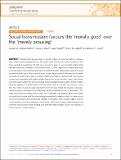Files in this item
Social transmission favours the ‘morally good’ over the ‘merely arousing’
Item metadata
| dc.contributor.author | Stubbersfield, Joseph M. | |
| dc.contributor.author | Dean, Lewis G. | |
| dc.contributor.author | Sheikh, Sana | |
| dc.contributor.author | Laland, Kevin N. | |
| dc.contributor.author | Cross, Catharine P. | |
| dc.date.accessioned | 2019-06-06T16:30:02Z | |
| dc.date.available | 2019-06-06T16:30:02Z | |
| dc.date.issued | 2019-06-04 | |
| dc.identifier | 259224618 | |
| dc.identifier | 93762a1e-36c2-4810-b611-42c8e3b3dfc7 | |
| dc.identifier | 85066616156 | |
| dc.identifier | 000472956800002 | |
| dc.identifier.citation | Stubbersfield , J M , Dean , L G , Sheikh , S , Laland , K N & Cross , C P 2019 , ' Social transmission favours the ‘morally good’ over the ‘merely arousing’ ' , Palgrave Communications , vol. 5 , 3 . https://doi.org/10.1057/s41599-019-0269-y | en |
| dc.identifier.issn | 2055-1045 | |
| dc.identifier.other | RIS: urn:0CF95C42059093A2420C3BA23BF7A61B | |
| dc.identifier.other | RIS: Stubbersfield2019 | |
| dc.identifier.other | ORCID: /0000-0001-8110-8408/work/60427418 | |
| dc.identifier.other | ORCID: /0000-0002-2457-0900/work/60630328 | |
| dc.identifier.uri | https://hdl.handle.net/10023/17837 | |
| dc.description | Authors thank the John Templeton Foundation for financial support (Grant #40128 to K.N.L.). | en |
| dc.description.abstract | Moral stories are pervasive in human culture, forming the basis of religious texts, folklore, and newspaper articles. We used a linear transmission chain procedure to test three competing hypotheses: (1) that moral content in general is preferentially transmitted between individuals compared to non-moral content; (2) that negativity bias leads specifically to morally bad content being preferentially transmitted; and (3) that a bias towards pro-social information leads specifically to morally good content being preferentially transmitted. While we found no support for a bias for moral content in general, we did find that morally good content was transmitted with greater fidelity than neutral or morally bad content, with ratings of morally good content but not morally bad content predicting transmission. Moral content, therefore, appears to be particularly culturally potent when it describes the ‘virtuous’ rather than the ‘sinful’. A second study repeated the first but also tested the influence of physiological arousal on transmission by measuring the electrodermal activity of participants. This study also found that morally good content was transmitted with greater fidelity than neutral or morally bad content and that physiological arousal had a negative effect on transmission with more arousing material being less faithfully transmitted. These results suggest that the communication of content relating to moral virtue might serve to avoid negative impression formation and promote social bonding, and that this might partially explain the ubiquity of moral content in human culture. | |
| dc.format.extent | 11 | |
| dc.format.extent | 785109 | |
| dc.language.iso | eng | |
| dc.relation.ispartof | Palgrave Communications | en |
| dc.subject | BF Psychology | en |
| dc.subject | DAS | en |
| dc.subject.lcc | BF | en |
| dc.title | Social transmission favours the ‘morally good’ over the ‘merely arousing’ | en |
| dc.type | Journal article | en |
| dc.contributor.sponsor | John Templeton Foundation | en |
| dc.contributor.institution | University of St Andrews. School of Biology | en |
| dc.contributor.institution | University of St Andrews. Centre for Biological Diversity | en |
| dc.contributor.institution | University of St Andrews. Scottish Oceans Institute | en |
| dc.contributor.institution | University of St Andrews. Institute of Behavioural and Neural Sciences | en |
| dc.contributor.institution | University of St Andrews. Centre for Social Learning & Cognitive Evolution | en |
| dc.contributor.institution | University of St Andrews. Centre for Research into Equality, Diversity & Inclusion | en |
| dc.contributor.institution | University of St Andrews. School of Psychology and Neuroscience | en |
| dc.identifier.doi | https://doi.org/10.1057/s41599-019-0269-y | |
| dc.description.status | Peer reviewed | en |
| dc.identifier.grantnumber | 40128 | en |
This item appears in the following Collection(s)
Items in the St Andrews Research Repository are protected by copyright, with all rights reserved, unless otherwise indicated.

